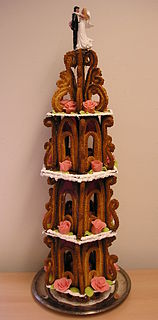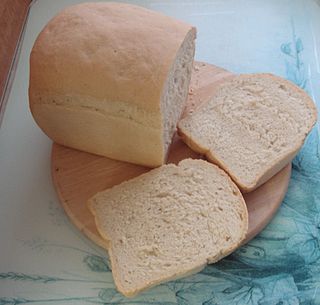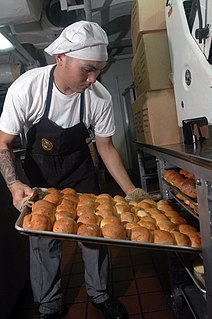Related Research Articles

A cookie is a baked or cooked snack or dessert that is typically small, flat and sweet. It usually contains flour, sugar, egg, and some type of oil, fat, or butter. It may include other ingredients such as raisins, oats, chocolate chips, nuts, etc.

Dessert is a course that concludes a meal. The course consists of sweet foods, such as confections, and possibly a beverage such as dessert wine and liqueur. In some parts of the world, such as much of Central Africa and West Africa, and most parts of China, there is no tradition of a dessert course to conclude a meal.

Confectionery is the art of making confections, which are food items that are rich in sugar and carbohydrates. Exact definitions are difficult. In general, however, confectionery is divided into two broad and somewhat overlapping categories: bakers' confections and sugar confections. The occupation of confectioner encompasses the categories of cooking performed by both the French patissier and the confiseur.

Baking is a method of preparing food that uses dry heat, typically in an oven, but can also be done in hot ashes, or on hot stones. The most common baked item is bread but many other types of foods can be baked. Heat is gradually transferred "from the surface of cakes, cookies, and pieces of bread to their center. As heat travels through, it transforms batters and doughs into baked goods and more with a firm dry crust and a softer center". Baking can be combined with grilling to produce a hybrid barbecue variant by using both methods simultaneously, or one after the other. Baking is related to barbecuing because the concept of the masonry oven is similar to that of a smoke pit.

Cake is a flour confection made from flour, sugar, and other ingredients, and is usually baked. In their oldest forms, cakes were modifications of bread, but cakes now cover a wide range of preparations that can be simple or elaborate, and which share features with desserts such as pastries, meringues, custards, and pies.

Pastry is baked food made with a dough of flour, water and shortening that may be savoury or sweetened. Sweetened pastries are often described as bakers' confectionery. The word "pastries" suggests many kinds of baked products made from ingredients such as flour, sugar, milk, butter, shortening, baking powder, and eggs. Small tarts and other sweet baked products are called pastries. Common pastry dishes include pies, tarts, quiches, croissants, and pasties.

A chocolate chip cookie is a drop cookie that features chocolate chips or chocolate morsels as its distinguishing ingredient. Chocolate chip cookies originated in the United States around 1938, when Ruth Graves Wakefield chopped up a Nestlé semi-sweet chocolate bar and added the chopped chocolate to a cookie recipe.

A baker is a tradesperson who bakes and sometimes sells breads and other products made of flour by using an oven or other concentrated heat source. The place where a baker works is called a bakery.

A muffin is an individually portioned baked product, however the term can refer to one of two distinct items: a part-raised flatbread that is baked and then cooked on a griddle, or an quickbread that is chemically leavened and then baked in a mold. While quickbread "American" muffins are often sweetened, there are savory varieties made with ingredients such as corn and cheese, and less sweet varieties like traditional bran muffins. The flatbread "English" variety is of British or other European derivation, and dates from at least the early 18th century, while the quickbread originated in North America during the 19th century. Both types are common worldwide today.

A biscuit is a flour-based baked and shaped food product. In most countries biscuits are typically hard, flat, and unleavened. They are usually sweet and may be made with sugar, chocolate, icing, jam, ginger, or cinnamon. They can also be savoury, similar to crackers. Biscuit may also refer to hard flour-based baked animal feed, as with dog biscuit.

Pound cake is a type of cake traditionally made with a pound of each of four ingredients: flour, butter, eggs, and sugar. Pound cakes are generally baked in either a loaf pan or a Bundt mold. They are sometimes served either dusted with powdered sugar, lightly glazed, or with a coat of icing.

Cheesecake is a sweet dessert consisting of one or more layers. The main, and thickest, layer consists of a mixture of a soft, fresh cheese, eggs, and sugar. If there is a bottom layer, it most often consists of a crust or base made from crushed cookies, graham crackers, pastry, or sometimes sponge cake. Cheesecake may be baked or unbaked.

Choux pastry, or pâte à choux, is a delicate pastry dough used in many pastries. Basic ingredients usually only include butter, water, flour and eggs.

A Swiss roll, jelly roll, roll cake, cream roll, roulade or Swiss log is a type of rolled sponge cake filled with whipped cream, jam, or icing. The origins of the term are unclear; in spite of the name "Swiss roll", the cake is believed to have originated elsewhere in Central Europe, possibly Austria or Slovenia. It appears to have been invented in the nineteenth century, along with Battenberg cake, doughnuts, and Victoria sponge. In the U.S., commercial versions of the cake are sold with the brand names of Ho Hos, Yodels, Swiss Cake Rolls, and others. A type of roll cake called Yule log is traditionally served at Christmas.

Cookie dough is an un-cooked blend of cookie ingredients. While cookie dough is normally intended to be baked into individual cookies before eating, it is also consumed raw.

Molten chocolate cake is a popular dessert that combines the elements of a chocolate cake and a soufflé. Its name derives from the dessert's liquid chocolate center, and it is also known as chocolate moelleux, chocolate lava cake, or simply lava cake. It should not be confused with chocolate fondant, a recipe that contains little flour, but much chocolate and butter, hence melting on the palate. It is a type of self-saucing pudding.

Spekkoek is a type of Indonesian layer cake. It was developed during colonial times in the Dutch East Indies. The firm-textured cake is an Indo (Dutch-Indonesian) version of the European multi-layered spit cake. However it is not baked on a rotating spit, and contains a mix of Indonesian spices, such as cardamom, cinnamon, clove, mace and anise. The cake is made of flour and yolk and is rich in butter or margarine.

Cake decorating is the art of dressing up of a cake for special occasions such as birthdays, weddings, national or religious holidays, or as a promotional good for a business. It is a form of sugar art that uses icing, frosting, fondant, and other edible decorative elements. Cake decorating can go beyond the simple art of dressing up a cake. There are cake decorators who have honed their skills in making amazing arts out of cake decorating: TV channels such as TLC, Food Network, and Discovery Family have showcased talented people who are cake artists. They give us a glimpse into how the cake may be molded during baking or sculpted after baking. It may take on simple or elaborate three-dimensional shapes as part of its decoration or as its entire decoration. Chocolate is commonly used to decorate a cake. It can be melted and mixed with cream to make a ganache or cocoa powder can be lightly dusted on top of a cake.

Sponge cake is a light cake made with egg whites, flour and sugar, sometimes leavened with baking powder. Sponge cakes, leavened with beaten eggs, originated during the Renaissance, possibly in Spain. The sponge cake is thought to be one of the first of the non-yeasted cakes, and the earliest attested sponge cake recipe in English is found in a book by the English poet Gervase Markham, The English Huswife, Containing the Inward and Outward Virtues Which Ought to Be in a Complete Woman (1615). Still, the cake was much more like a cracker: thin and crispy. Sponge cakes became the cake recognized today when bakers started using beaten eggs as a rising agent in the mid-18th century. The Victorian creation of baking powder by English food manufacturer Alfred Bird in 1843 allowed the addition of butter to the traditional sponge recipe, resulting in the creation of the Victoria sponge.

The old-fashioned doughnut is a variety of cake doughnut prepared in the shape of a ring with tapered edges around it. Cake doughnuts originated in the United States circa 1829. Primary ingredients in the old-fashioned doughnut include flour, sugar, eggs, sour cream or buttermilk, and leavener. It is typically deep fried, may have a crunchier or crisper texture compared to other styles of cake doughnuts, and typically has cracks and pores on its surface. After being fried, it is glazed, dusted with sugar, or served plain.
References
- ↑ Saffitz, Claire (10 April 2018). "This Easy Sheet Cake Recipe Doesn't Seem Like It Should Work, but It's Incredible". Bon Appetit. Condé Nast. Retrieved 19 August 2019.
- ↑ Adams, Glen (28 April 2017). "Cake mixing methods". King Arthur Flour. Retrieved 19 August 2019.
- ↑ Kuhn Rikon Chef's Corner. "Featured Chef Rose Levy Beranbaum". Kuhn Rikon Switzerland. Archived from the original on 17 January 2013. Retrieved 21 November 2012.
- ↑ "Us". Real Baking with Rose. Retrieved 2022-07-12.